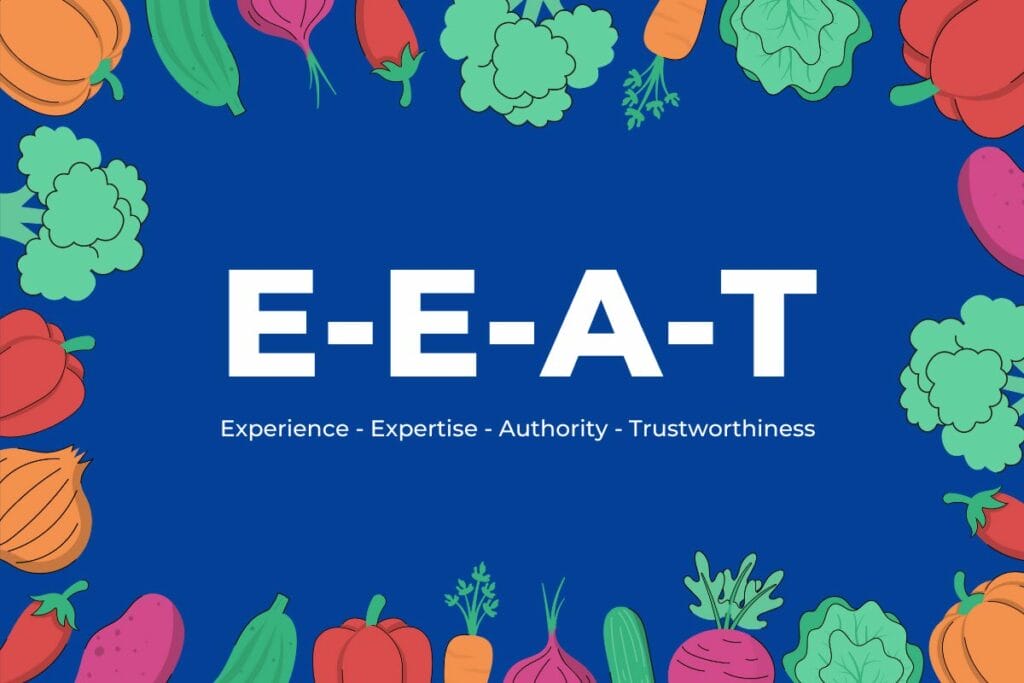Updated post from October 16, 2019

Improve Your Website’s E-E-A-T
We’ve all been to web pages that contain low-quality content. Some can even be detrimental to us by providing false or misleading information. Worse yet, we might not realize we’re being duped.
Here’s the minimum you need to know about E-E-A-T, including Top Of The List’s own checklists to determine if your site meets the guidelines.
E-E-A-T
To ensure Google places high-quality sites at the top of their search results, they developed Search Quality Evaluator Guidelines called E-E-A-T.
E stands for Experience, another E for Expertise, A for Authoritative, and T for Trustworthiness. If your site meets all of these, you’re in good graces with Google. These guidelines have been around for quite a while.
Over the past several years, the guidelines have been working their way into algorithm updates like never before.
Manual Reviewers

Google hires manual reviewers called raters. The raters are armed with instructions and checklists on what to do on your site and what to look for.
Their experiences are documented, so Google can determine if their desired guidelines are being met.
Reviewing and updating your web page content to meet Google’s guidelines should be a continuous goal to give it the best chances for high placement. While you’ll have to read the guidelines to get all the details (which are updated periodically), we’ve created checklists showing a summary of the guidelines that should be applied to your website.
Raters usually rate individual pages, although a smaller part of the E-E-A-T guidelines applies to the entire site.
While raters may visit more pages on your site to accomplish a task, their primary task is to rate the specific page or pages they are assigned. Thus, it’s important to look at all of your pages individually, rather than just “does the site meet this guideline?”
Note that reviewers cannot possibly review all sites on the web manually. None of the data they collect for a site is directly added to Google’s search algorithms for that site.
But collectively, the data is likely used to determine future algorithm changes. As history has shown, when Google wants websites to conform to something and most are not doing so, there’s an algorithm change that pretty much forces the issue.
Understanding Webpages and Websites
This section of the guidelines contains information that raters need to complete their jobs and requires them to make decisions on what type of site or page they are reviewing. It includes:
- Definitions
- Determining the purpose of a web page (share content, entertain, sell, etc.)
- YMYL (see below)
- Understanding the website – each piece of content on a page must be classified as Main Content (MC), Supplementary Content (SC), or Ads
- The reputation of the website or content author(s) – the rater must look offsite to find this information
Of all of the above, YMYL has the greatest effect on sites that are grouped into this bucket. Thus, we’ll go into it in more detail.

What is YMYL?
YMYL stands for Your Money or Your Life. According to Google, these guidelines apply to “pages that could potentially impact the happiness, health, or wealth of users.” YMYL pages require higher page quality and E-E-A-T ratings. The stricter standards apply to pages representing:
- News and current events: International events, business, politics, science, or technology. Sports, entertainment, or lifestyle are generally not YMYL.
- Civics, government, and law: Information about voting, government agencies, public institutions, social services, and legal issues (divorce, child custody, adoption, creating a will, etc.).
- Finance: Includes eCommerce, investment, banking, taxes, retirement planning, and more.
- Shopping: Web pages that allow people to purchase online, or information about or services related to research or purchase.
- Health and safety: Medical issues, drugs, hospitals, emergency preparedness, or information about dangerous activities.
- Groups of people: Pages about groups such as race or ethnic origin, religion, disability, age, nationality, veteran status, sexual orientation, gender or gender identity.
- Other: A catch-all category that includes nutrition, fitness, housing information, choosing a college, finding a job, and other topics that could impact YMYL.
Page Quality Ratings
Page quality ratings can get complex. The guidelines break the ratings into the following types (and in this order):
- High-Quality Pages
- Highest Quality Pages
- Low-Quality Pages
- Lowest Quality Pages
- Medium Quality Pages
There are characteristics of each, examples of what a “satisfying” amount of content would deserve a specific rating type, what level of E-E-A-T is required to meet that rating type, reputation to meet that type, and more. All this and you’re still only through part 1.
Part 2 is about understanding mobile user needs, Part 3 goes into Google’s “Needs Met” rating system (on-site search queries and results), and finally, there’s an Appendix about using the evaluation platform.
Our minimum checklists for E-E-A-T

It is not easy to wade through the guidelines, and even more difficult to determine what each individual client website might need. But we tried and came up with some lists from Part 1 that we use to review our clients’ websites.
While there are most certainly some items missing from these lists, it is a start and is in a little easier-to-follow format than the Google guidelines.
All websites
- Terms & Conditions policy – make sure you have one for your site
- Privacy Policy – with the date that it was last updated
- Cookie Policy – This can be located within the Privacy Policy
- Name, address, and phone # on all pages – hint: make sure it displays exactly as shown in your Google Business Profile listing
- Is there an “About” page?
- Is your site secure? (HTTPS)
- Can you access the home page from all other pages (link or click on the logo)?
- Is it clear who is responsible for your site (contact us page)?
- Are domain email addresses used? ex: name@domain.com
- Are the authors and posting date listed on your blog posts, advice, and news pages?
- Do those authors have a profile page that demonstrates their expertise, experience, authority, and trustworthiness on the subject?
- Is the blog or other article type written regularly?
- Overall, are you providing a good amount of quality content?
- Does supplementary content distract from – or is it unhelpful to – the main content – as in, are there too many ads, call-outs, or overly large navigation areas?
- Is any of the content “stolen” or borrowed from other sites?
- Is there a useful 404 page (including links or a search box – or some way to direct users back to the homepage)?
- Is the website accessible to people with disabilities?
- An HTML sitemap in addition to an XML sitemap
YMYL Sites
- All items in All Websites above
- Do the site’s blog posts get shared on social media (by other than the business itself)?
- Are there external links to helpful sources?
- Number of positive reviews as of (date)
- Google Business Profile
- Tripadvisor
- Trustpilot
- Yelp
- BBB
- Other
- Does the site have a good reputation (check reviews; a few can be negative depending on the reason, source, and quantity)?
Ecommerce Websites
- All items in All Websites and YMYL Sites above
- Ease of finding a product intuitively
- How easy is it to purchase a product
- Easy to locate policy on payment, exchanges, and returns
- Ease of checkout policy – there should be no surprises
- Is the shipping cost available before purchase?
- Does the shopping cart store items you plan to buy?
- Can you create a wishlist?
- Ability to sort category pages and search results by price, weighted relevance, review score, bestsellers, or similar criteria
- Can the categories and search results be filtered by product features and tags?
- Responsive design that looks good on mobile and desktop
- Is there a modern search capable of interpreting queries with misspellings or similar words that are not specifically what is on the description page?
- Does the site include high-quality content on product pages: i.e., manufacturer’s product specs, original product information, shipping and returns information, [and] multiple images of the product?
- Is the site produced by the manufacturer of the product and is that evident?
- Does the site contain user reviews of the products?
As you can see, getting your website to comply with the guidelines can be a lot of work. But for SEO reasons and the benefit of your users, it’s time to get going.
If ensuring your website meets the E-E-A-T guidelines seems a bit overwhelming for you to take on, don’t hesitate to contact Top Of The List for some help. It’s what we do regularly, and we enjoy helping other sites do it right!
Sources:
The guidelines: https://static.googleusercontent.com/media/guidelines.raterhub.com/en//searchqualityevaluatorguidelines.pdf
What it means for ecommerce: https://www.searchenginewatch.com/2018/09/07/what-googles-e-a-t-score-means-for-ecommerce/
General info: https://moz.com/blog/google-e-a-t
About The Authors

Bev founded Top Of The List in 2006 and has over 25 years of experience working with technology. In her free time, she competes in dog agility competitions with her Golden Retrievers, Cosmo, and Finn.

Mandie joined Top Of The List in 2018 and has a degree in Web Development. She lives in Grand Rapids, MI with her dog Winnie.




